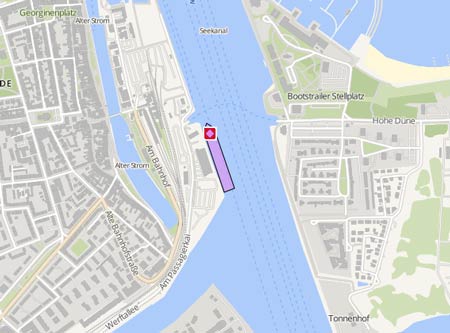CORAL DISCOVERER
Kurs/Position
Die letzten Häfen
Die letzten Wegpunkte
Die neuesten Nachrichten
Cruise ship assisted in rescue of yacht crew
On Jan 15, 2018, the "Coral Discoverer" assisted the 40-ft-yacht "Claire de Lune" which had run aground at Cape Raoul on the Tasman Peninsula. The crew, a 51-year-old woman and a 54-year-old man, both from Noumea in New Caledonia, were winched to safety by the Westpac Rescue Helicopter, and also the "Coral Discoverer" immediately made its way to the area to assist. The rescue authorities were sending a helicopter but asked if the cruise ship could get the tenders down as well. The Tasmania Police co-ordinated the rescue liaising with the cruise ship and the rescue helicopter. The yacht crew made mayday calls via VHF radio about 4.30 a.m., and the police was also contacted by the AMSA Rescue Co-ordination Centre in Canberra after the emergency beacon was activated at the western side of Cape Raoul, south of Port Arthur. The cruise ship moved to more sheltered water on the eastern side of Cape Raoul and launched tender vessels to provide help and a rescue by water if required. The big tender "The Explorer" and one of the Zodiacs were launched and remained on standby at the yacht on the rocks while the chopper hoisted the pair which had made their way to shore from the boat. About 7 a.m. they were winched to safety by the rescue helicopter from rocks just south of Shipstern Bluff. Both were uninjured. Report with photo: http://www.themercury.com.au/news/tasmania/pair-plucked-to-safety-after-yacht-runs-aground-off-cape-raoul-in-tasmanias-south-east/news-story/57ca7f922493a32b4f1c37845ec2e32b
Coral Princess Cruises fined $180,000 after crewmember killed by powered door
Coral Princess Cruises has been fined $180,000 following the death of a crewman after he was trapped by a powered door while working on the cruise ship Oceanic Discoverer in 2009. The company was found to be non-compliant with the Occupational Health and Safety (Maritime Industry) Act 1993 in Cairns Magistrates Court on Tuesday, 30 October. It was also non-compliant with the Navigation Act 1912 and the Code of Safe Working Practice for Australian Seafarers.
Report on deadly accident released
An hydraulic fire door which closed at twice the allowable speed, trapping a man, was named as a contributor to the death of the "Oceanic Discoverer"'s chief engineer at the Port of Napier on February 19, 2009. The Transport Accident Investigation Commission now has released its report into the incident. It said the crew was conducting a fire and emergency drill and closing and testing the hydraulic water-tight doors. The master closed the doors remotely from the bridge and some minutes later the chief engineer opened the doors to the engine room. But for some reason he became trapped by the door as he passed through the doorway for more than eight minutes before he was found and the crew was able to free him. He was resuscitated but never regained consciousness and later died in hospital. The doors were normally set to "local-control mode. At the time of the accident, the doors were in "remote-close mode", when they would automatically close when the user released the opening handle. The report said the door had been set to close at twice the allowable closing speed, which would have probably contributed to the accident. The chief engineer, an Australian of Sri Lankan descent, possibly tried to pass through the door before it was fully opened and for some reason it began closing and trapped him. It is possible that the audible alarm warning that the door was closing, was not working at the time. A failure of the audible alarm may have contributed to the accident. The commission's investigation found the water-tight door did not comply with the minimum requirements of the International Convention for the Safety of Life at Sea. The safety management systems on board did not ensure the doors were maintained in line with regulations or good marine engineering standards. The commission recommended Maritime New Zealand and the International Marine Organisation "address" the issue of water-tight door safety. It also wanted the Australian Maritime Safety Authority to address issues with the safety management system on board the Oceanic Discoverer. The manufacturer of the water-tight doors would also have to look at possible design issues, while the International Association of Classified Societies and its surveyor members would be alerted to the safety issues outlined in the report, so they would be aware when conducting tests and surveys on water tight doors.
News schreiben

